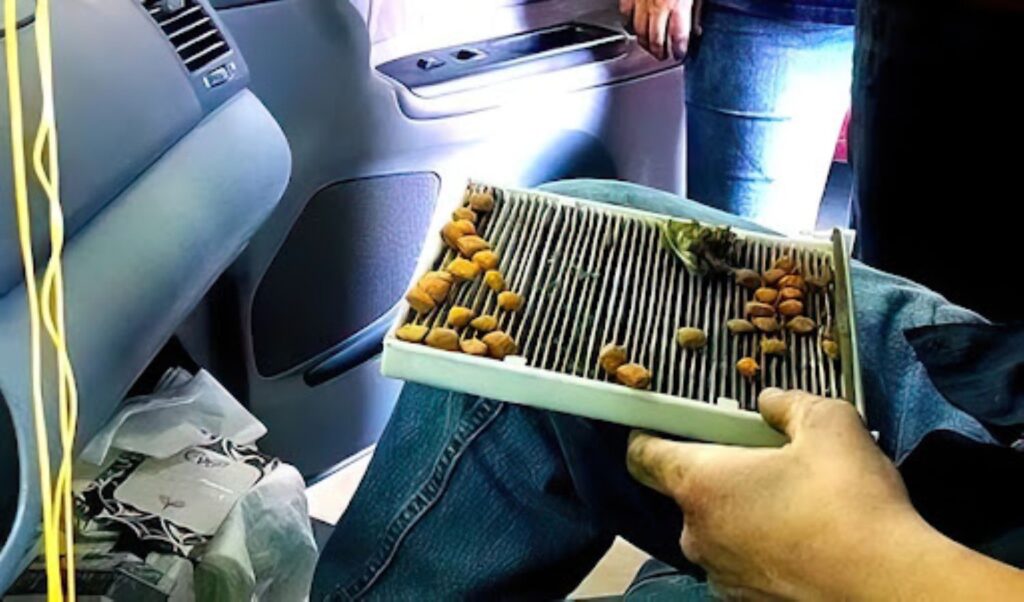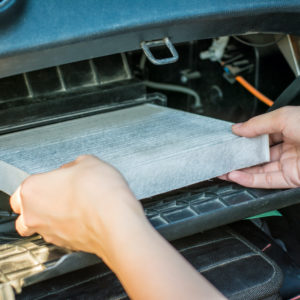The cabin air filter ensures that the air quality inside your vehicle is clean and safe for you and your passengers to breathe.
What Is a Cabin Air Filter?
As part of your car’s climate control system, the cabin filter is vital in making sure the heating, ventilation, and air-conditioning systems in your car function properly. It’s responsible for keeping dust, smoke, and larger objects like insects and leaves from entering the cabin. It also helps defrost and defog your car windows by maintaining an adequate airflow in the cabin.
Most cabin air filters are made of a paper or foam filter with a plastic frame. While each filter varies on the car model, there are four main types: particulate, charcoal, activated carbon, and electrostatic cabin filters.

Cabin air filters first appeared on the Ford Contour back in 1995, and they were added to the Ford Taurus in 1996. These were 25 Micron filters, and like all cabin air filters, they do a wonderful job of keeping dust and pollen out of the engine compartment when the A/C is being run on “Normal” rather than “MAX/Recirc.”
Many vehicles don’t have cabin air filters, so your vehicle may not have one at all. The cabin air filter is a good thing, but it’s not totally necessary. Cabin air filters on some vehicles are impregnated with horseradish because of its antibacterial properties, and some high-end cars even have an ultraviolet lamp directed so that it shines on the cabin air filter area for the same reason.
Cabin air filters are sometimes mounted just behind the glove box, but sometimes they’re mounted right in the center of the bulkhead. Nissan Altimas (2000s vintage) have a two-piece cabin air filter where the filters are stacked edge-on-edge for greater filter area.
Cabin air filters are sometimes mounted just behind the glove box, but sometimes they’re mounted right in the center of the bulkhead. Nissan Altimas (2000s vintage) have a two-piece cabin air filter where the filters are stacked edge-on-edge for greater filter area.
–Richard McCuistian, ASE Certified Master Automobile Technician
What Are the Symptoms of a Bad Cabin Air Filter?
There are several signs you can look out for to diagnose a bad cabin air filter.
Unpleasant Smell
A foul odor in your vehicle typically results from a build-up of dirt and mold on the cabin filter, with the smell intensifying every time the air-conditioning (A/C) is turned up. It’s best to replace your filter before the smell gets too unbearable and makes everyone in the car uncomfortable.
Poor Airflow
A contaminated filter restricts the airflow passing through the interior vents. You might notice it takes much longer for your A/C to make your cabin colder, causing you to turn the A/C up. This can cause the A/C in your vehicle to exert more effort than it should. Prolonged strain on your A/C system can damage the blower motor.

Defogging Windows Takes Too Long
Poor airflow in the vents caused by a dirty cabin air filter can also cause poor defogging. During rainy or foggy days, condensation will naturally form on your windows and windshield, blocking your view when driving.
A functioning cabin filter helps clear out this fog by clearing the moisture in your vehicle. If you notice that it takes too long for your windows to defog, it’s best to check your cabin air filter, as driving with foggy windows can be dangerous.
Visible Debris and Dust
If dust starts piling up on your dashboard more often, then this could also be due to a dirty cabin air filter. A dirty filter can no longer effectively keep dust, smoke, and other particles from entering your vents and piling up on your dashboard and seats. If you’re sensitive to dust, then it’s a good idea to get your cabin filter checked regularly.
Unusual Noise Coming From Air Vents
If you have a clean cabin air filter, you should only hear the soft noise of your A/C’s fan. Any rattling or whistling noise from the air vents might be a sign that it’s time to replace your cabin air filter. Insects, stones, or leaves probably entered the vents because the filter failed to keep them out. To prevent any more pollutants from entering the cabin, it’s best to replace your filter as soon as possible.

Bad Cabin Air Filter FAQ
Because a dirty cabin filter can no longer effectively keep smoke and debris out of your vehicle, it can make you sick. Those who suffer from allergies, asthma, and other respiratory diseases will also find it hard to stay inside the car.
Going too long without replacing it can also trap allergens in the cabin, making passengers breathe in more fumes than they would when walking down the street. This is why it’s especially important to change your cabin filter during the summer, when there’s plenty of pollen, dust, and other allergens in the air.
You can identify a dirty cabin air filter simply by looking at it. The location of the filter varies, but you can typically find it under your car’s hood, near the cowl, or under your dashboard. If it has dust and debris on the surface or turned a darker color, then it might be time for a replacement.
You should replace your cabin air filter every year or every 12,000 miles. You can also check your owner’s manual, which usually includes the recommended interval for replacing it. However, if you often drive in dusty areas with heavy pollution or start to see any of the bad cabin air filter symptoms we’ve discussed, consider getting it replaced more frequently.
The price of a cabin air filter can range from $10 to $150 depending on its brand and your vehicle’s model.
Where to Get a New Cabin Air Filter
A dirty or clogged cabin filter causes a decrease in the airflow coming from the vents inside your vehicle. It could also lead to dust, smoke, or even insects entering the cabin. Thankfully, you can easily get a new filter with CarParts.com.
With just a few clicks, you can find and order a new filter here at CarParts.com. Use our advanced filters to narrow down your options to your preferred brand, type, and quantity. Don’t forget to enter your vehicle’s year, make, and model into the vehicle selector to view compatible filters.
We source our cabin air filters from trusted manufacturers in the industry to ensure their quality. Shop now, and we’ll deliver what you need to your doorstep in a few days. Got questions? Our round-the-clock support team is always ready to help.
Don’t put up with the problems caused by a clogged or dirty cabin air filter. Check out our selection of new cabin air filters at CarParts.com.
Any information provided on this Website is for informational purposes only and is not intended to replace consultation with a professional mechanic. The accuracy and timeliness of the information may change from the time of publication.
































